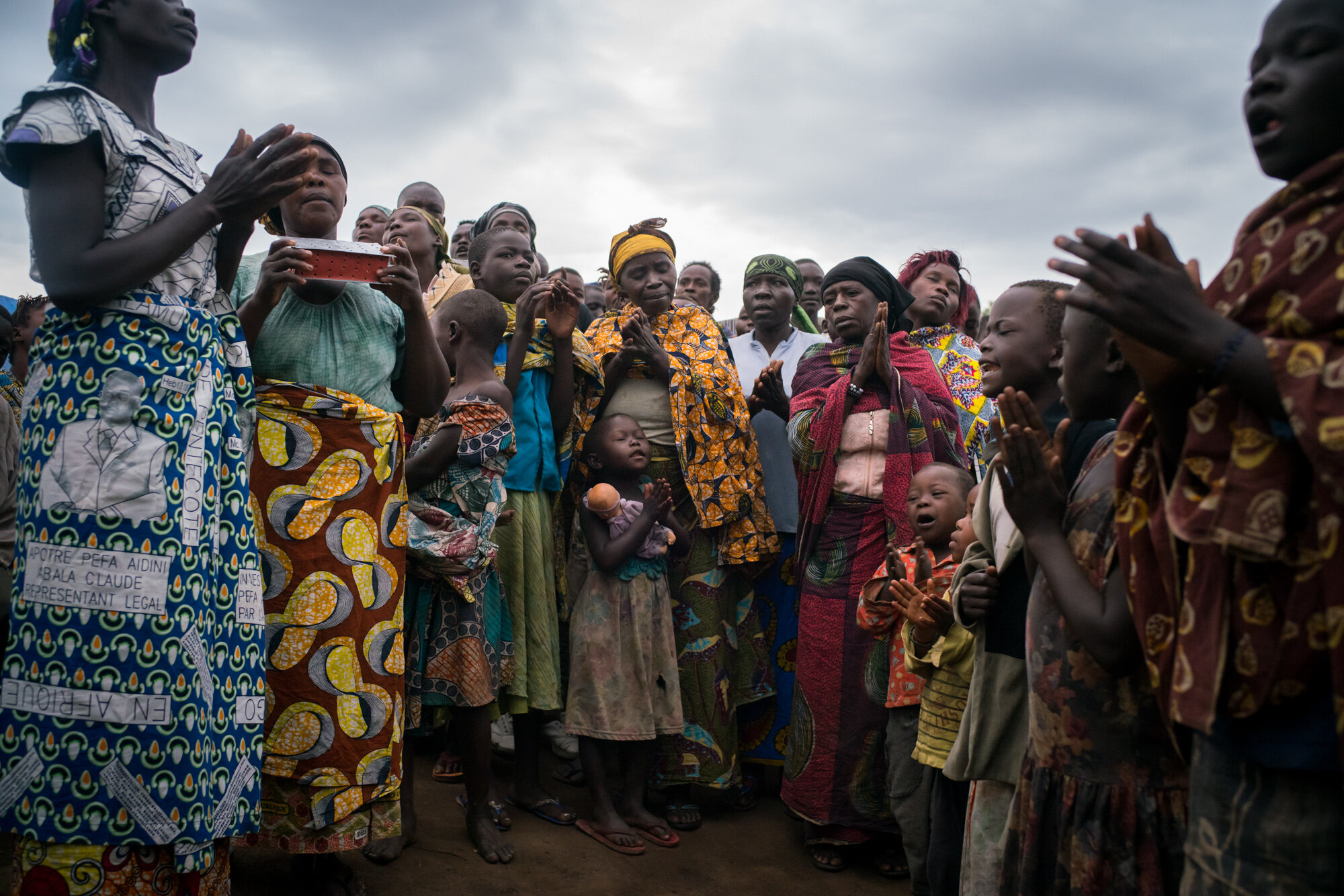
IDPs attend a sermon in the largest camp in Bunia, host to approximately 10,0000 people. A second camp in Bunia hosts apporximately 4400 people. According to UN OCHA, the total number of those displaced to Bunia, living in camps and with host families is approximately, according 65,000, and the totoal bumber of IDPs from Ituri since January is is approximately 250,000. April 2, 2018. Bunia, Ituri province, Democratic Republic of the Congo.
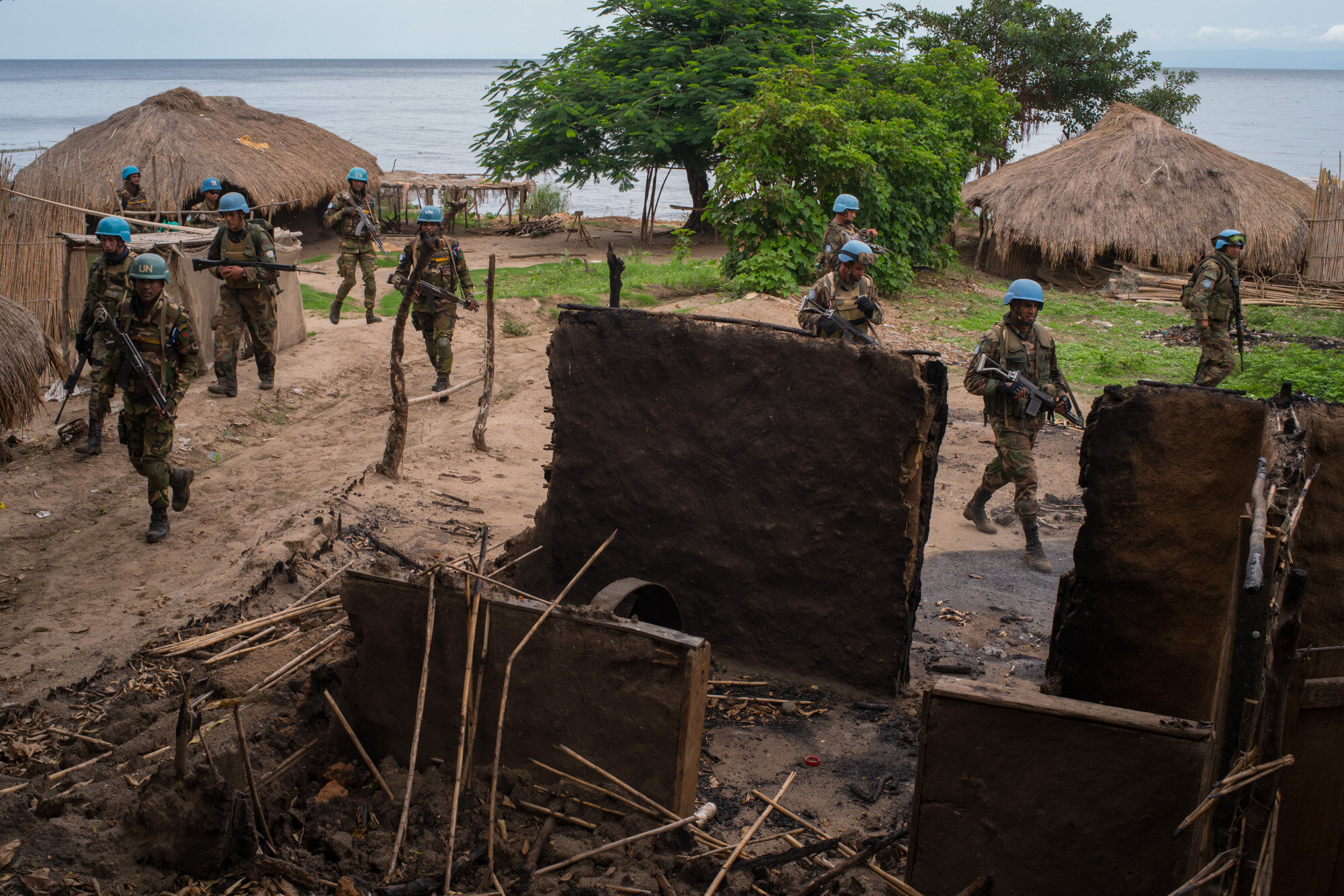
Soldiers from the Armed Forces of the DRC, and UN peacekeeprs from the Uruguyan and Bangladesh batallions move through Ghat, a deserted lakeside village that lies in ruins after attacks from militias less than a week prior. They have come here to meet six Uruguyan soldiers who after succeeding to reach Joo, a decimated village further up the coast, were stuck there for three days and nights, surrounded by militias. March 18, 2018. Ghat, Djugu territory, Ituri province, Democratic Republic of the Congo.
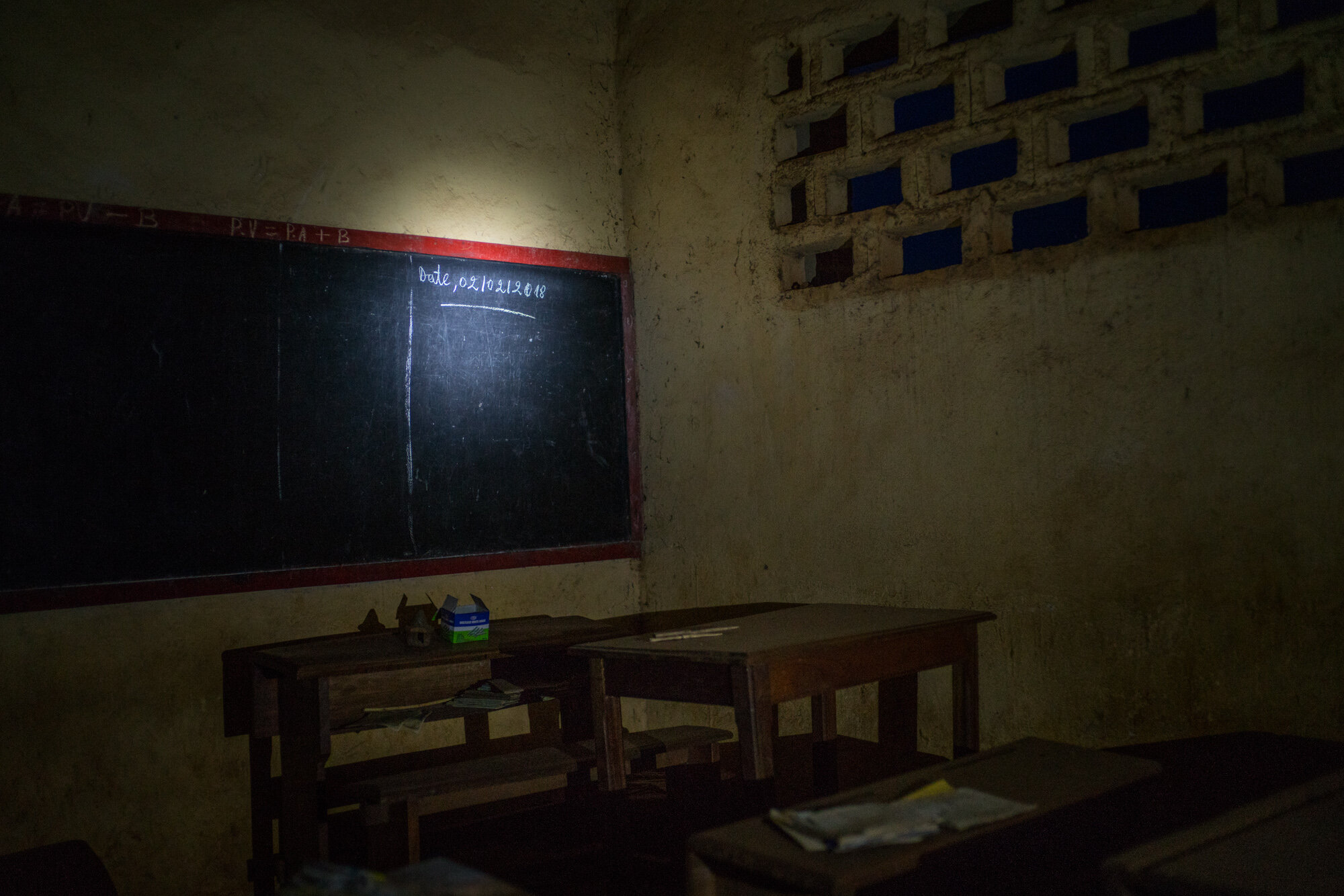
The date on the blackboard of a ransacked classroom marks the last time class was held at the school in Lita, a town deserted and in ruins after it was attacked on March 4, 2018. Behind the school, the Uruguyan batallion of the UN peacekeeping mission to the DRC (MONUSCO) built a small field base from which they can have quicker access various parts of their operational zone in the troubled territoty of Djugu. March 16, 2018. Lita, Ituri province, Democratic Republic of the Congo.
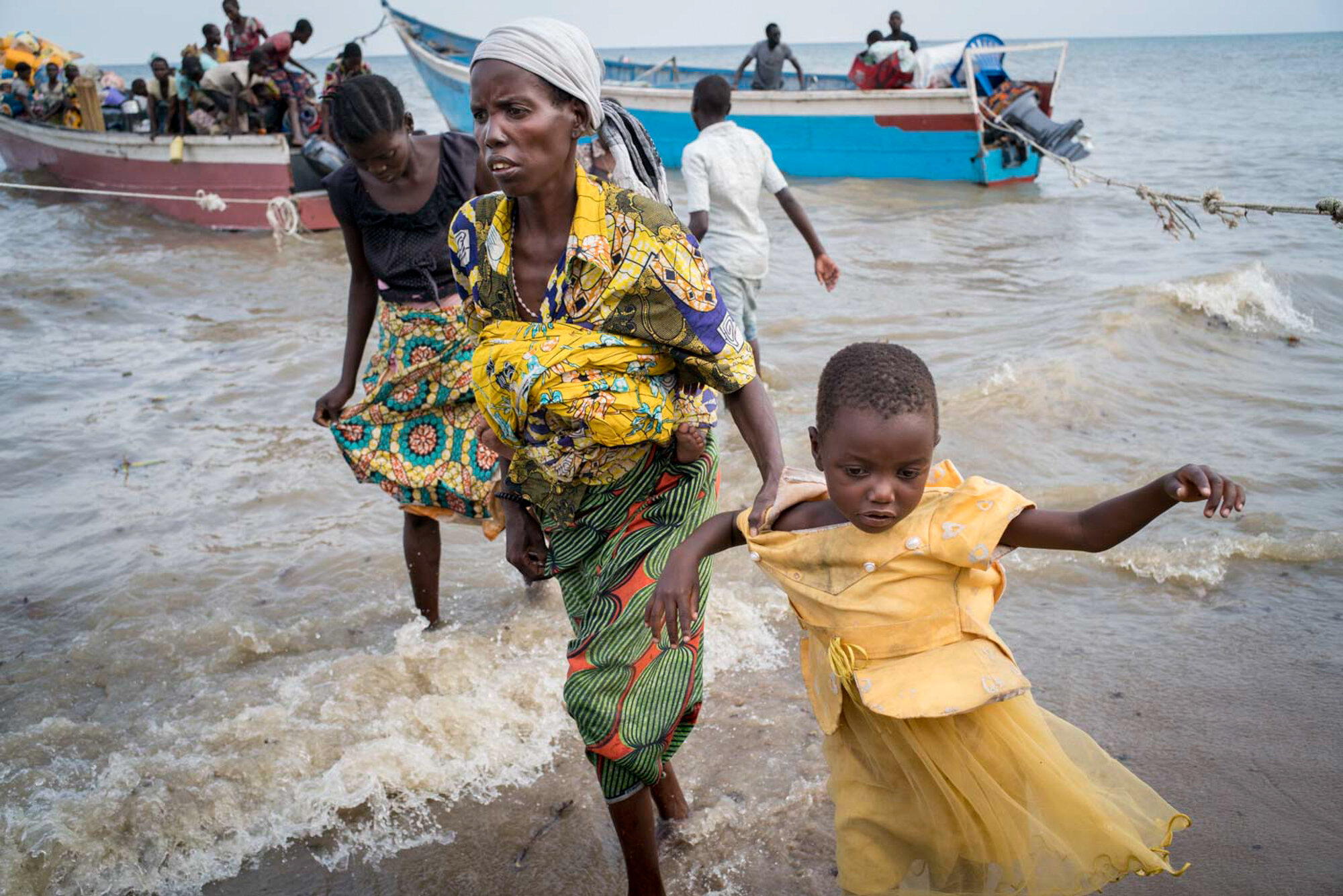
Congolese refugees arrive to Sebagoro, Uganda, via boats used to cross Lake Albert, after fleeing the conflict in their home province of Ituri, Congo. Sebagoro, Hoima province, Uganda. March 9, 2018.
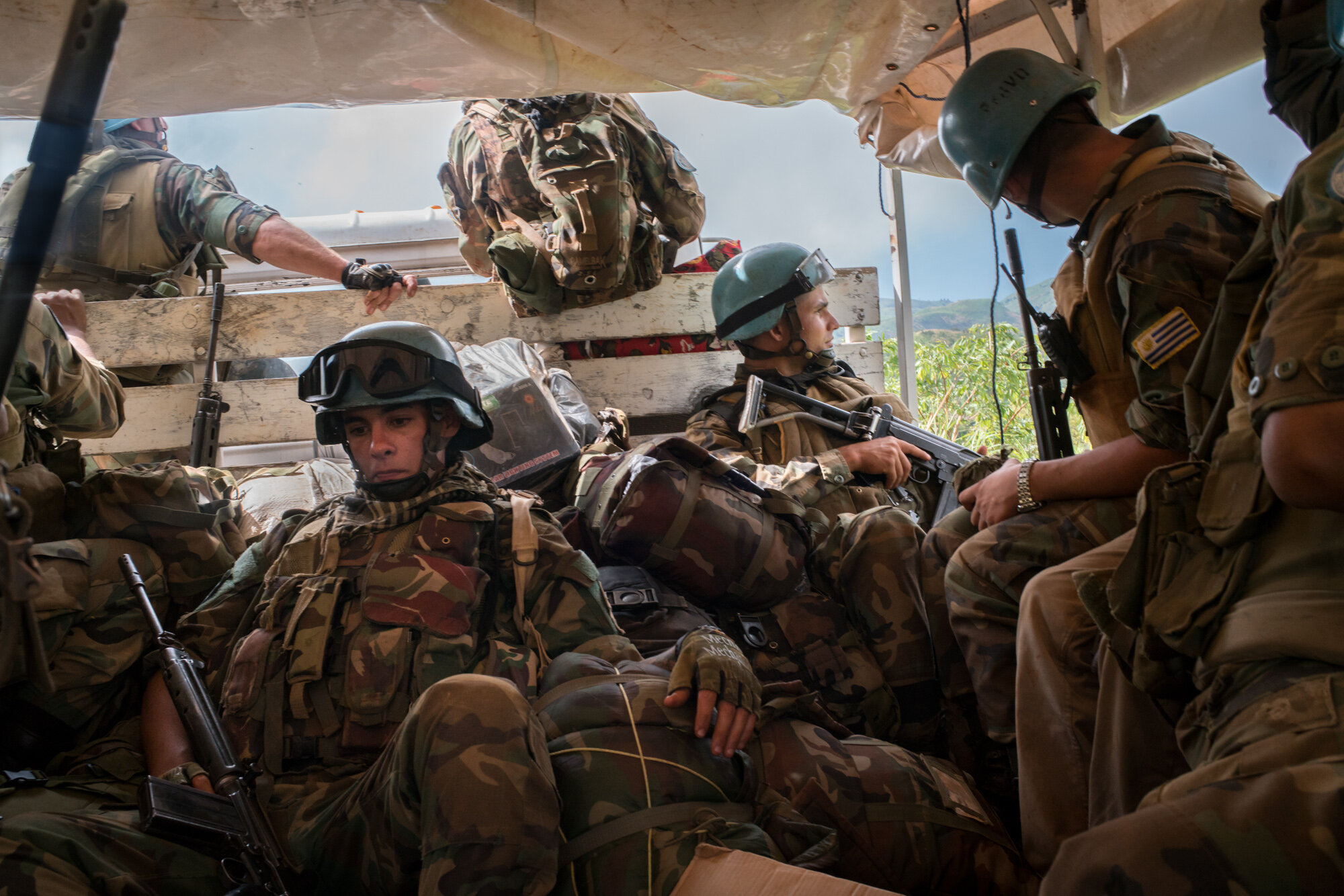
Uruguyan peacekeepers travel from Bunia to Kafe, on an operation to reach Joo, Ghbi and Dii, three remote villages were 42 were left dead after attacks on March 12. The villages are nestled between the shores of Lake Albert and a string of mountains, making them particularly difficult to reach. March 22, 2018. Djugu territory, Ituri province, Democratic Republic of the Congo.

Cadavers line the lakeshore in Joo, one of the villages that was attacked on March 12, leaving reportedly 42 people massacred. This is the body of Justin, 47, a fisherman. The location of the villages - wedged between Lake Albert and mountains - makes it particularly difficult to reach them. Uruguyan peacekeepers were the first to reach Joo after the massacre, on March 16, after crossing the mountains on foot. They found cadavers and militias, who attacked them on two occasions over the three days and nights the soldiers spent there. On March 22, Uruguyan forces returned to Joo. The militias were again spotted in the surrounding clifftops. March 22, 2018. Joo, Ituri province, Democratic Republic of the Congo.
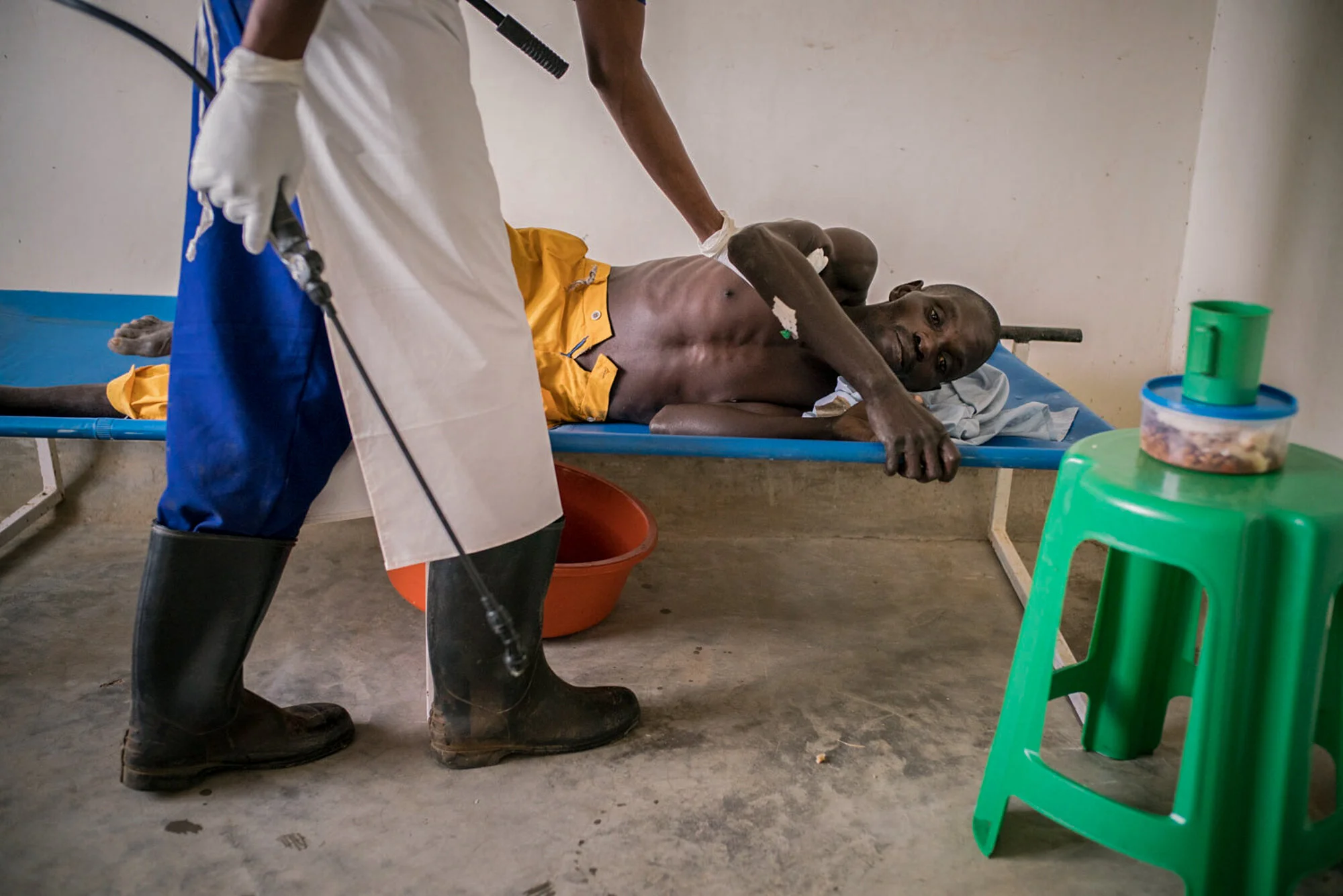
Medicins Sans Frontiers / Doctors Without Borders cholera treatment center. Sebagoro, Hoima province, Uganda. March 9, 2018.
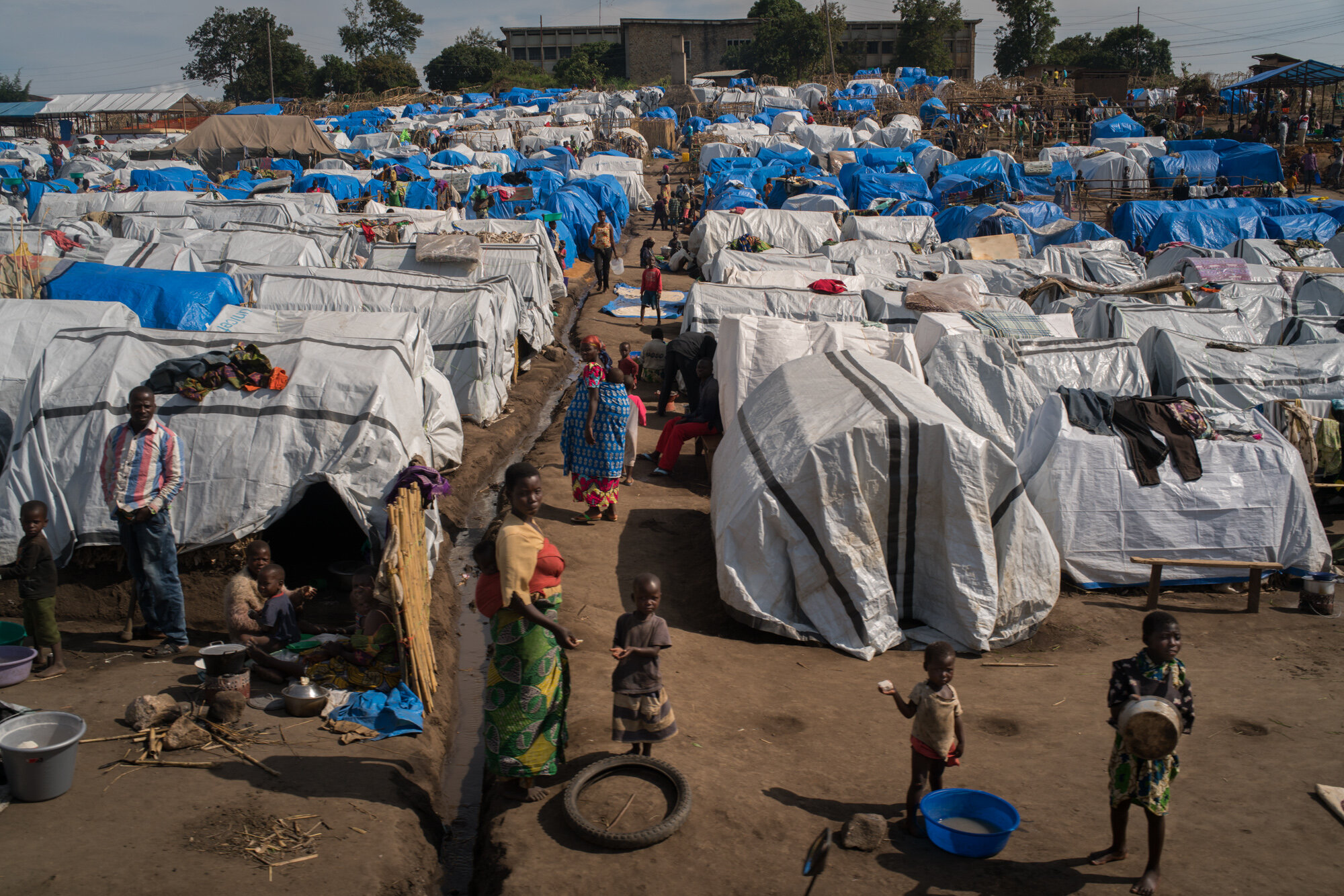
IDPs in the largest camp in Bunia, host to apporximately 10,0000 people. A second camp in Bunia hosts apporximately 4400 people. According to UN OCHA, the total number of those displaced to Bunia, living in camps and with host families is approximately, according 65,000, and the totoal bumber of IDPs from Ituri since January is is approximately 250,000. March 19, 2018. Bunia, Ituri province, Democratic Republic of the Congo.
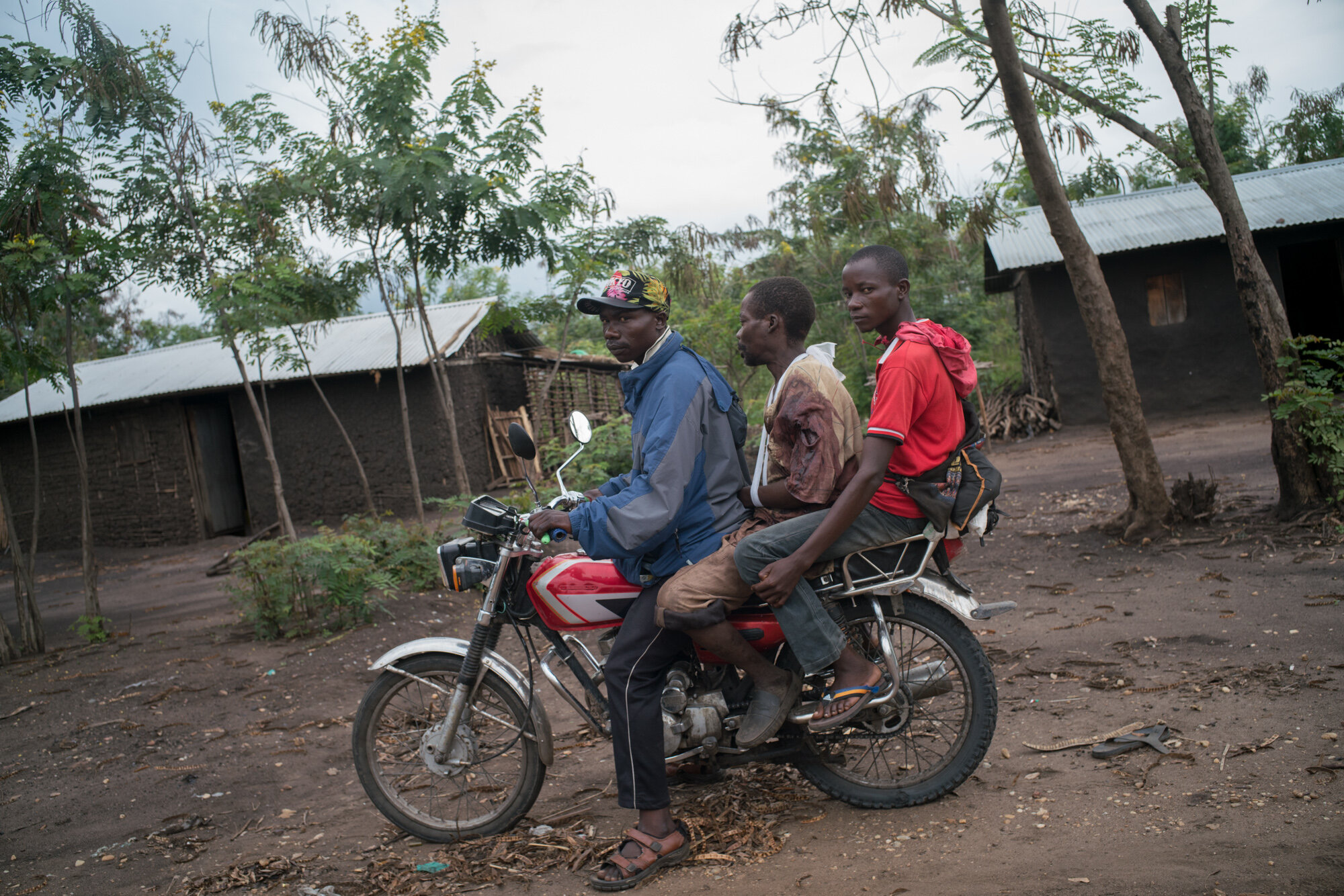
Villagers transport a man out of Nyamamba village, where he had been hiding in the nearby bush when militias found him and shot him. Nyamamba lies in ruins after attacks a week prior. March 18, 2018. Nyamambda, Ituri province, Democratic Republic of the Congo.
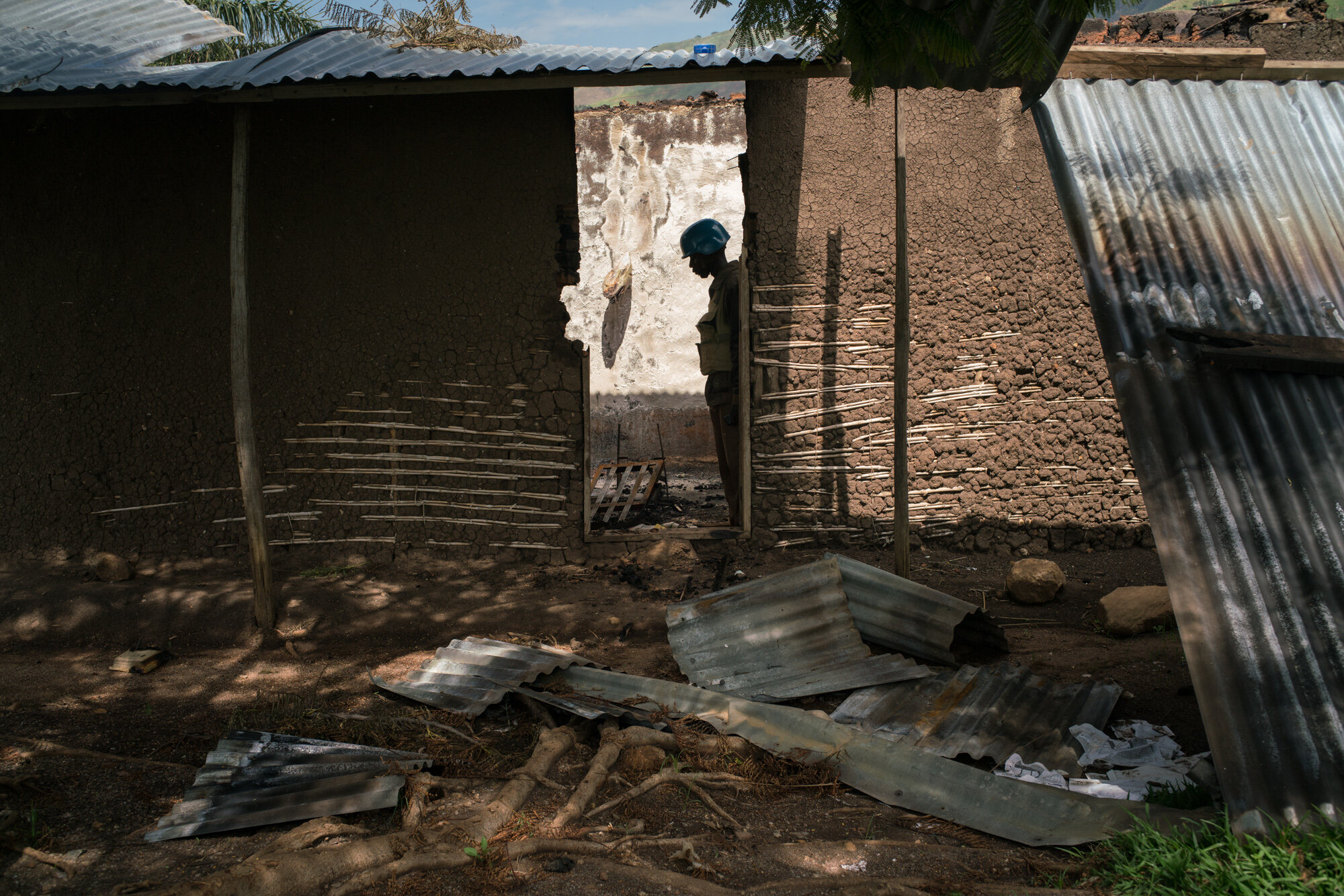
Basima Bovias Nyau, 41, the chief of Dii surveys the scortched ruins of what was once the health clinic in his mountaintop village, attacked on March 13, just after the attacks on the previous day in the villages at the foot of the mountain, along the coast of Lake Albert, left a reportedly 42 people massacred. Even though they saw the neighboring lakeside villages attacked, people of Dii didn't leave because that same day, the village Chief of Dii spoke to the FARDC, and they told him they were going to arrive to protect them. But the FARDC never came. On March 13th, militias arrived - the burned the village and killed people. The location of the villages - wedged between Lake Albert and mountains - makes it particularly difficult to reach them. Uruguyan peacekeepers were the first to reach the lakeside village of Joo, on March 16, after crossing the mountains on foot. They found cadavers and militias, who attacked them on two occasions over the three days and nights the soldiers spent there. On March 22, Uruguyan forces returned to Joo, and on March 23, they reached Dii. The militias were again spotted in the surrounding clifftops. March 23, 2018. Dii, Ituri province, Democratic Republic of the Congo.
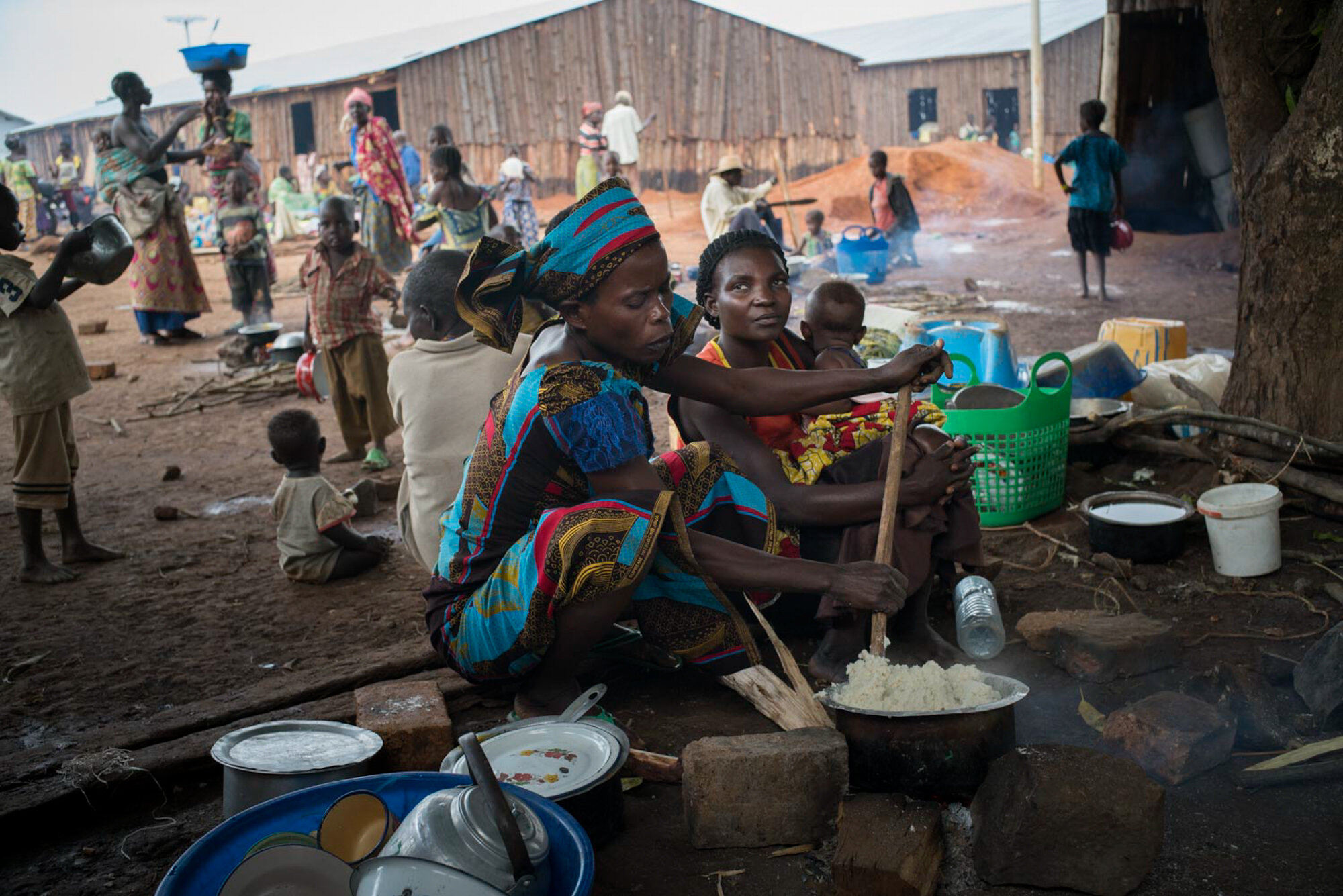
Congolese refugees wait at the reception center in Kyangwali, Uganda, where refugees spend several days before being transferred to a settlement (aka camp). Since December, approximately 50,000 refugees have arrived on boats used to cross Lake Albert, after fleeing the conflict in their home province of Ituri, Congo. Sebagoro, Hoima province, Uganda. March 8, 2018.
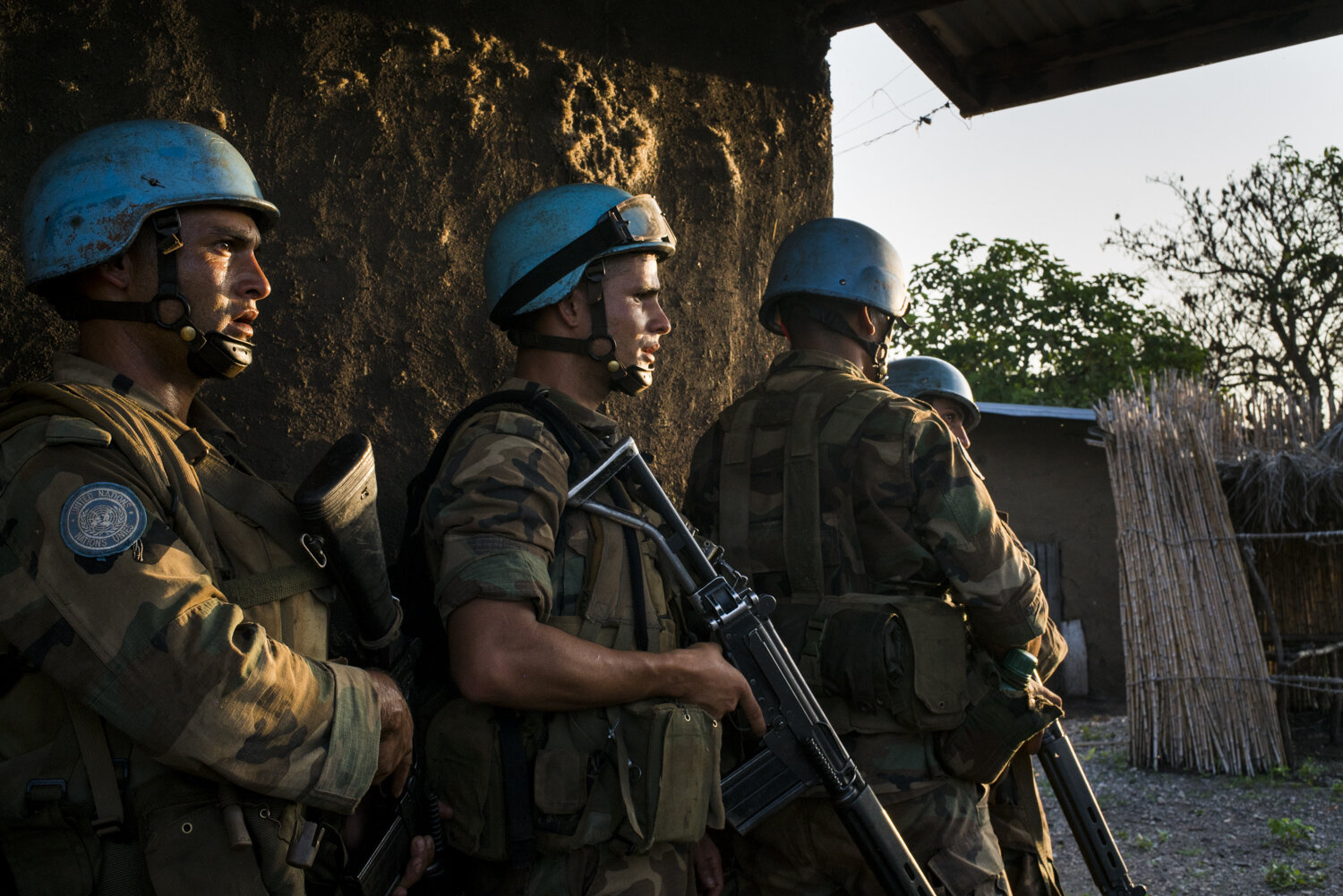
Uruguyan peacekeepers reach Ghbi, one of the extremely remote villages on the coast of Lake Albert that has been deserted since March 12, when attackers burned down homes and left a reported 42 massacred in this area. On March 16th, the peacekeepers were the first soldiers to reach the villages since the attacks. They found cadavers and clashed with militias on two occasions. March 23, 2018. Ghbi, Ituri province, Democratic Republic of the Congo.
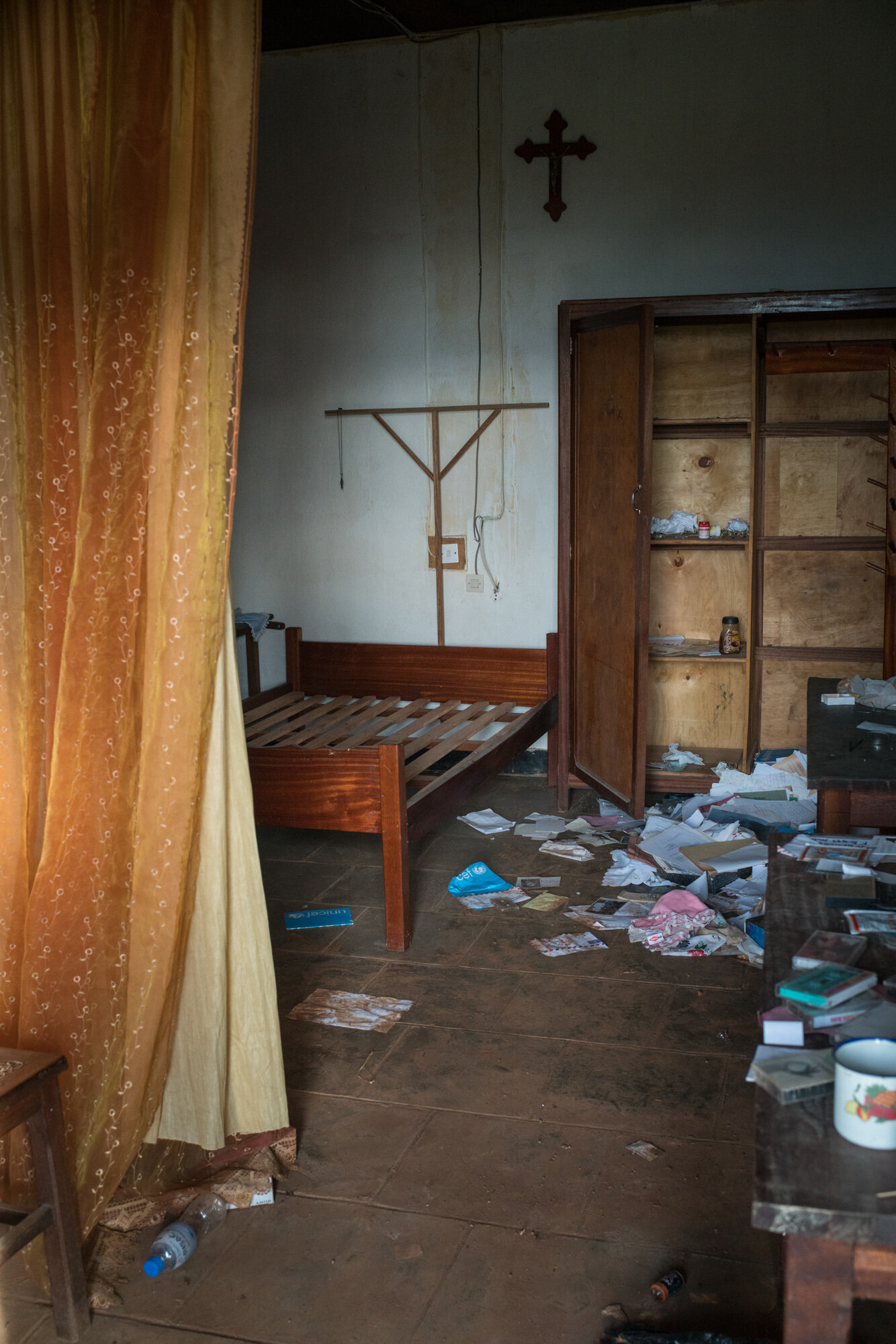
The ransacked priest's chamber in the cathedral in Lita, a town deserted and in ruins after it was attacked on March 4, 2018. Next door, behind the school, the Uruguyan batallion of the UN peacekeeping mission to the DRC (MONUSCO) have built a small base from which they can have quicker access various parts of their operational zone in the troubled territoty of Djugu. March 21, 2018. Lita, Ituri province, Democratic Republic of the Congo.
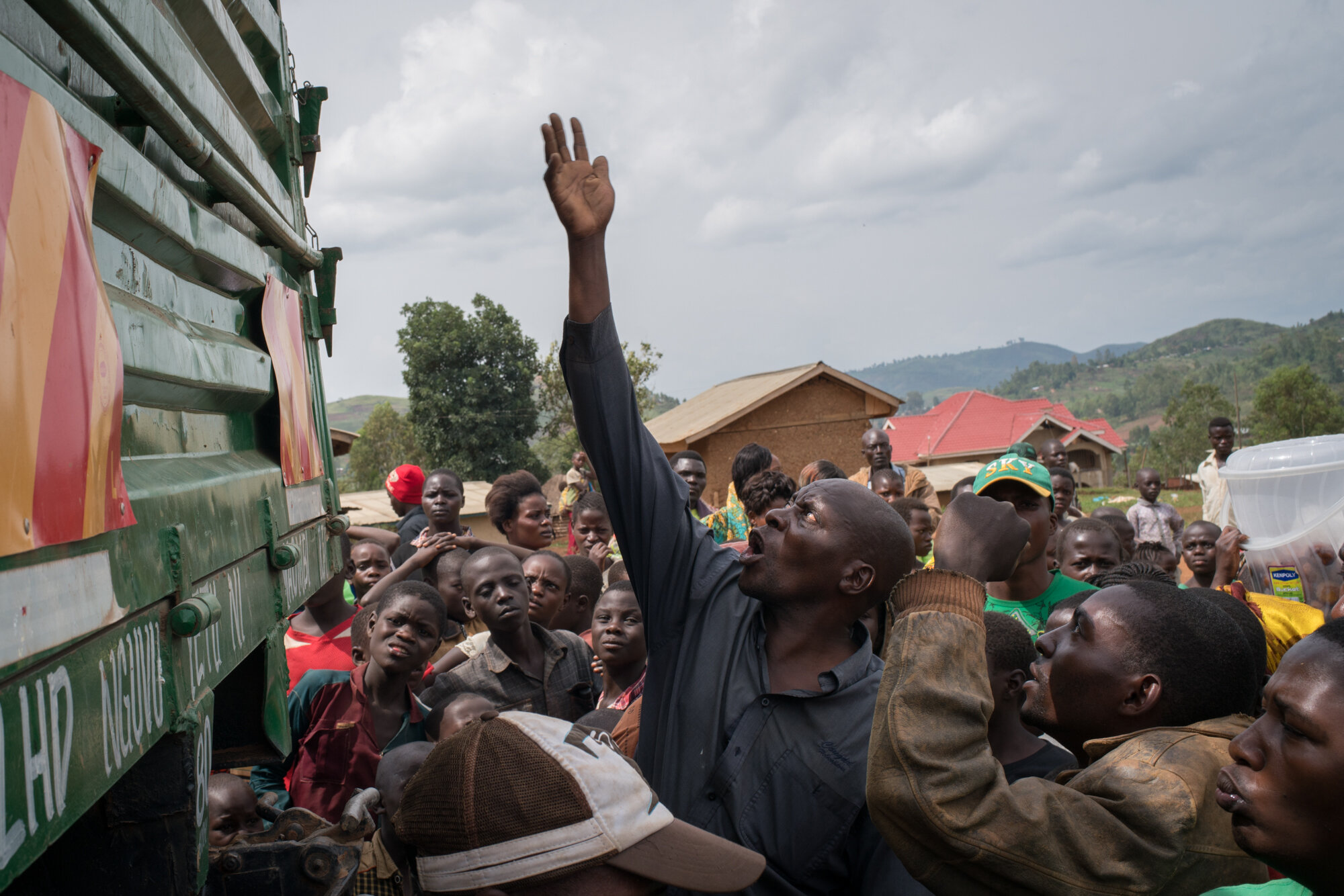
IDPs receive the first distribution of aid since their arrival to Iga-Barriere town, 32 km north of Bunia, which marked the border of the red zone. To the north of it, countless villages were attacked by militias, who burned down the villages and killed inhabitants using machetes, arrows and fire arms. The most vulnerable IDPs received kits of non-food items - two blankets, 2 mosquito nets, a Jerry can, 1 plastic sheet, 2 mats, 5 soaps, 5 spoons - from Doctors Without Borders / MSF. March 15, 2018. Iga-Barriere, Ituri province, Democratic Republic of the Congo.
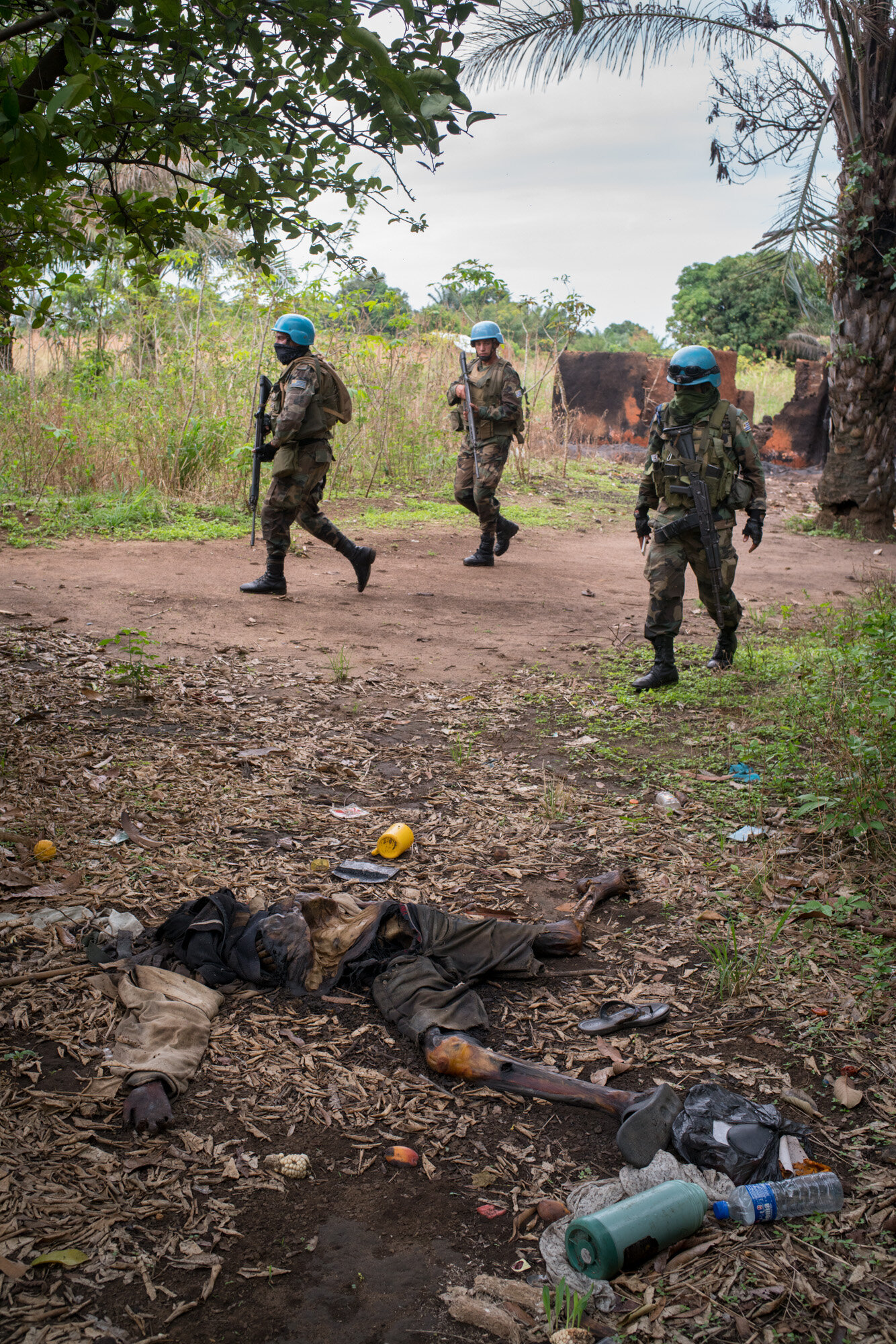
Soldiers of the Uruguyan forces to MONUSCO, the UN peacekeeping mission in the DRC, discover a partially decomposed corpse in Nyamamba, a deserted lakeside village that lies in ruins after attacks from militias a week prior. March 18, 2018. Nyamamba, Djugu territory, Ituri province, Democratic Republic of the Congo.
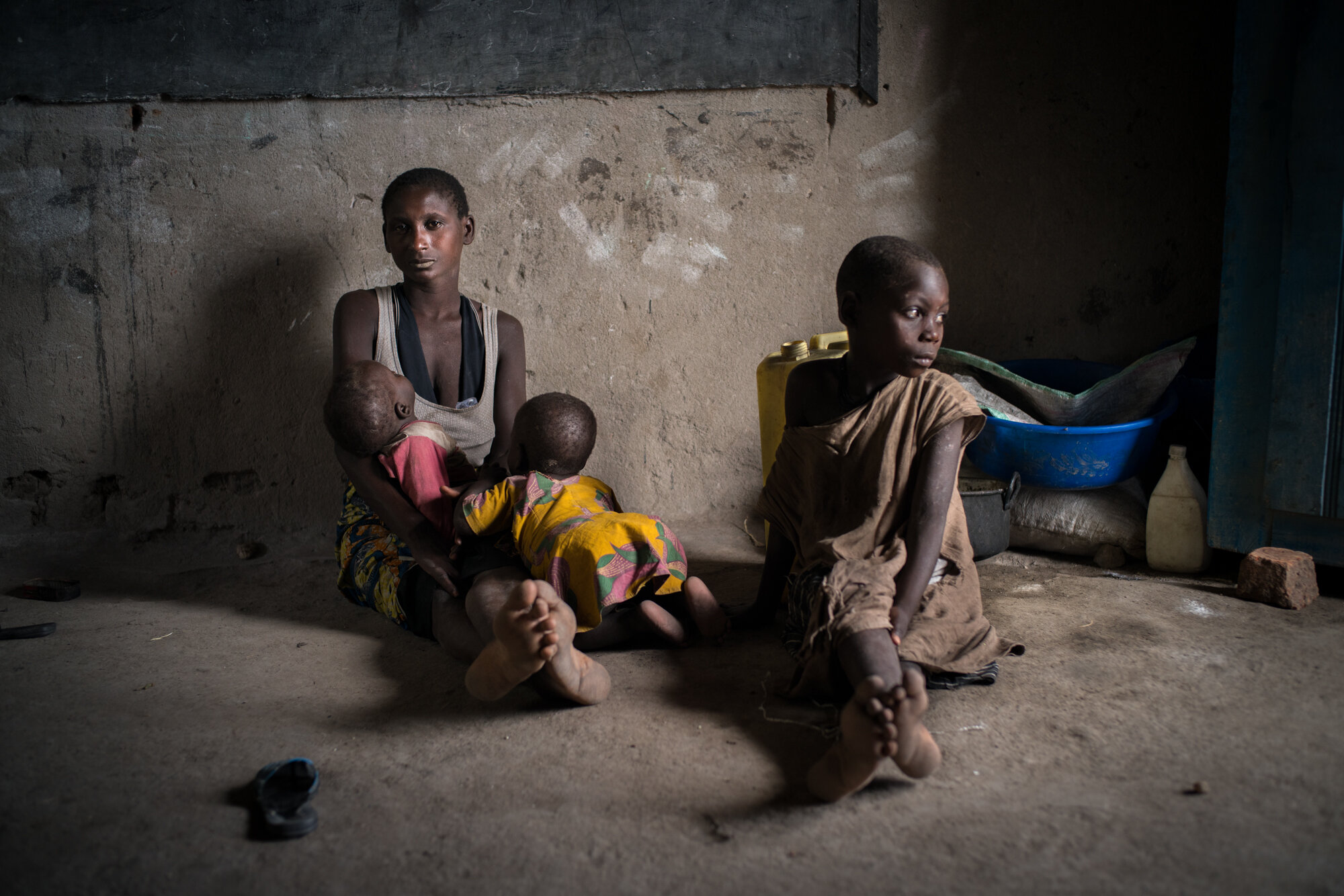
Francois Love, 30, and her children seek shelter in a school in Kasenyi, a town on the coast of Lake Albert. Kafe - mother of 5 - left 5 days ago. People here have fled their villages after militias arrived, burning houses and attacking people with machetes, arrows and firearms. Until a few days prior, IDPs gathered in Tchomia, X kilometers to the north. But when all villages to the north of Tchomia were attacked, leaving houses burned and many dead, IDPs deserted Tchomia as well, in fear of attacks reaching there. They now gather in Kasenyi. March 14, 2018. Kasenyi, Ituri province, Democratic Republic of the Congo.
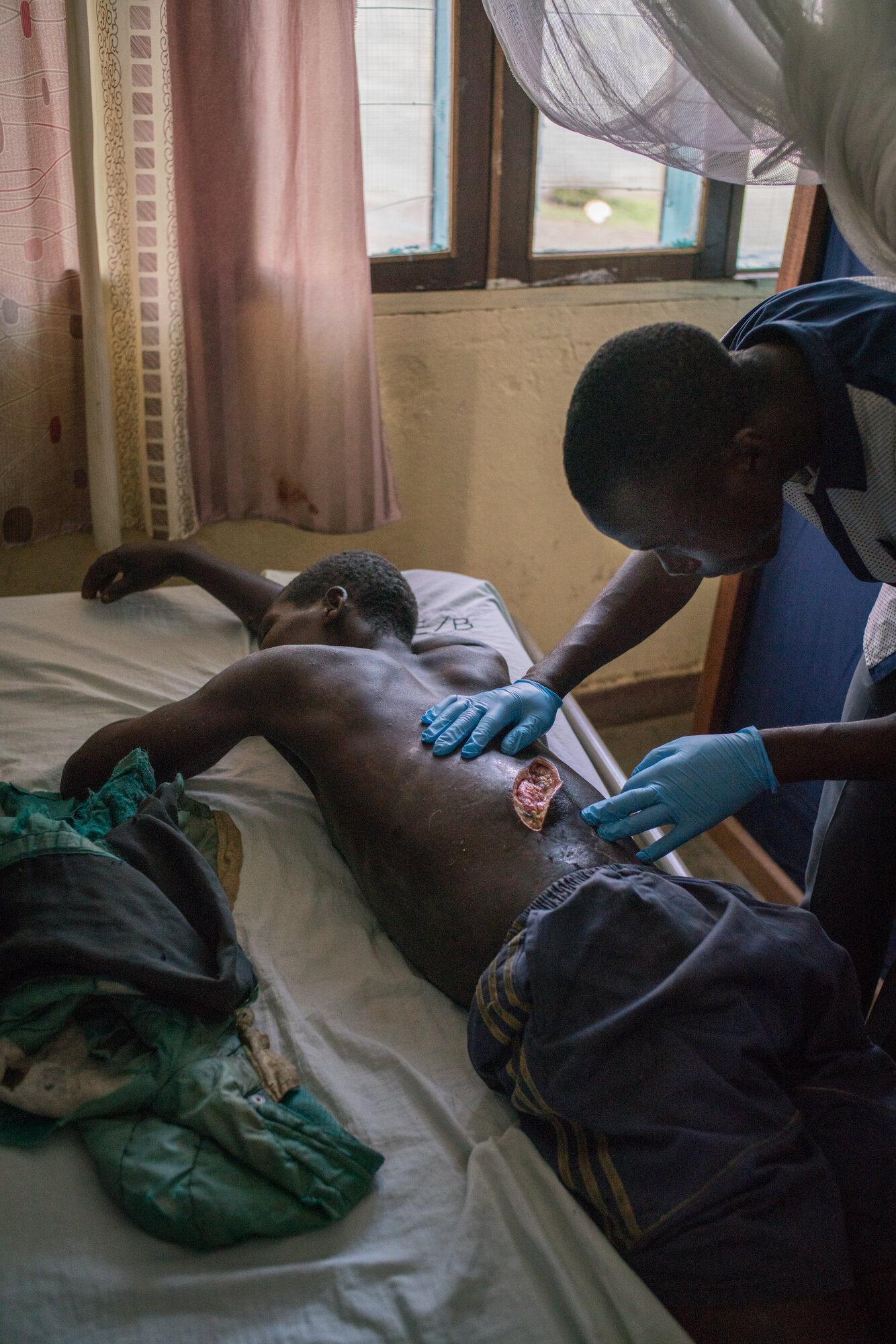
Floribert Lobini, 42, receives treatment for his wounds - a machete slash across his back and a puncture in his arm by an arrow - in the hospital in Bunia. Floribert fled his lakeside village of Dzu when it was attacked on March 12, along with other villages on the coast. Reports said 42 were killed that day. He was next to the lake when he saw the attackers. Fortunately, his wife and three children had already left for Tchomia, the nearest town considered safe harbor. The attackers slashed Floribert with machetes, and shot at him with arrows. He managed to escape and hid in the bush for two days. When he came out to check on the village, he came across three corpses. He fled to Tchomia, but when he arrived there, he found it too was already deserted. In the hospital, he found one doctor who had stayed behind. Until recently, Tchomia had been a key point of refuge for those displaced by the conflict as well as the point of embarkation for those leaving by boat to Uganda. Once villages just to the north were burned down and massacred, people decided to flee from Tchomia as well, fearing attacks would reach there soon. The local doctor in Tchomia alerted Doctors Without Borders/ Medicins Sans Frontiers (MSF) about Floribert’s situation, so MSF made a special mission into the “red zone”, to rescue Floribert from Tchomia, in the “red zone”. At first, Floribert refused to leave Tchomia, saying he didn't want to leave his wife and children behind; he didn't know where they were. He was also afraid to go to Bunia as he had never been there before. MSF workers convinced him to get in the car: if he stayed in Tchomia, he would have died as the town was completely abandoned. March 14, 2018. Bunia, Ituri province, Democratic Republic of the Congo.
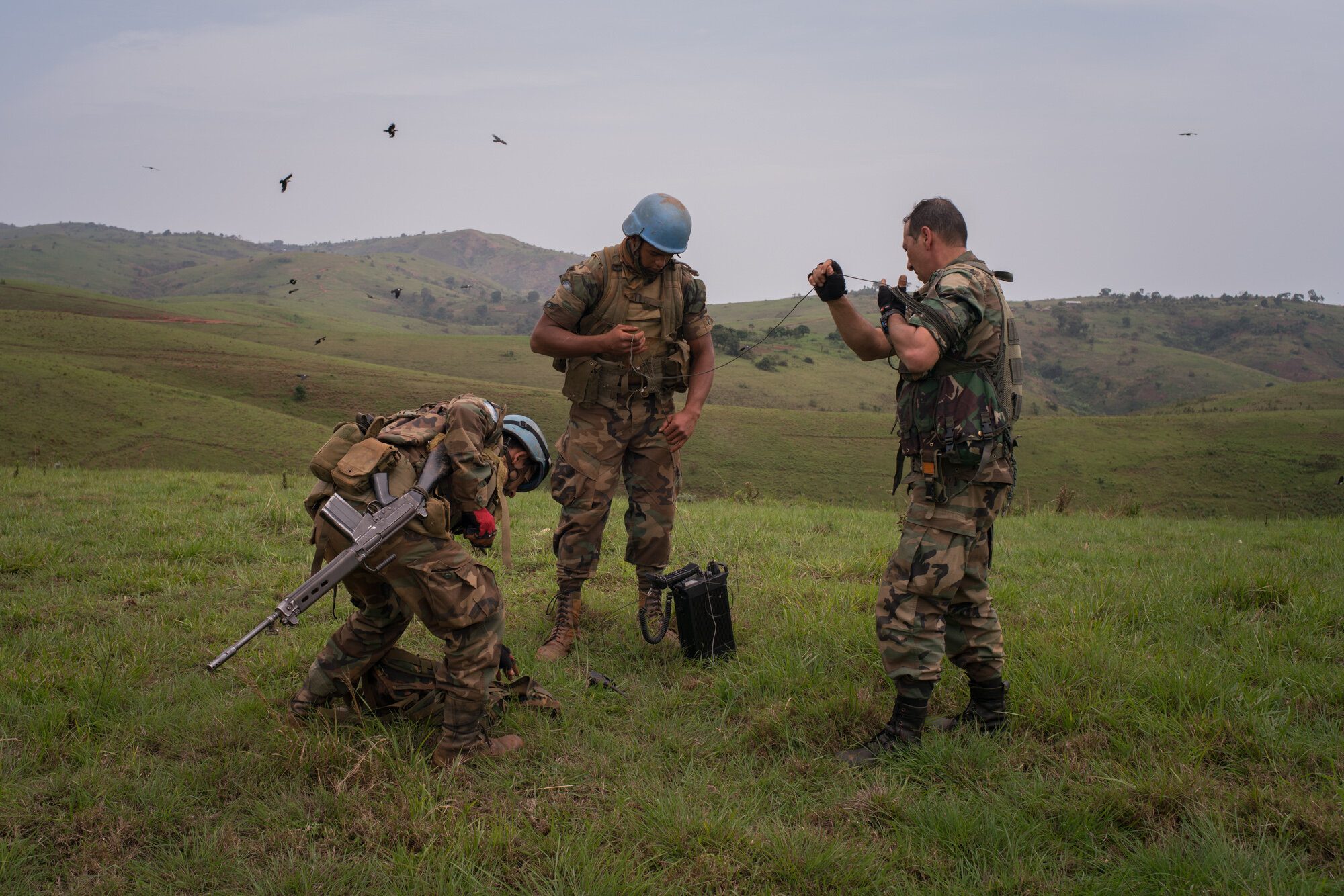
Soldiers from the Uruguyan forces of MONUSCO, the UN peacekeeping mission in the DRC, stops at Logo to try to make a radio call to 16 fellow soldiers who have gone missing for over 24 hours on a mission to reach Joo, one of the villages on the remote coast of Lake Albert in which 42 were reported dead after attacks on March 12. Beyond this point, roads are impassable by car and there is no FARDC or peacekeeper presence. They will go on foot to search for their lost colleagues. Poor communication networks, lack of roads, and mountainous terrain makes it especially difficult to secure territories like Djugu. March 16, 2018. Logo, Ituri province, Democratic Republic of the Congo.
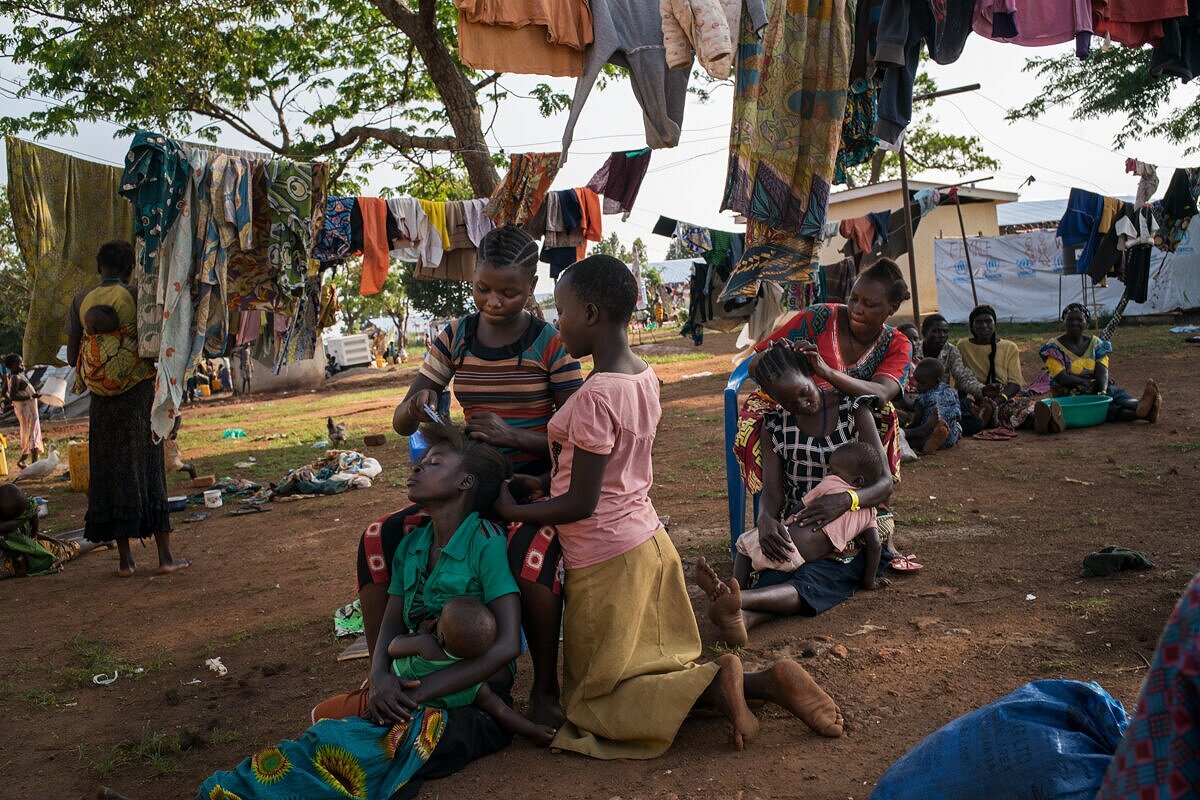
Congolese refugees wait at the reception center in Kyangwali, Uganda, where they spend several days before being transferred to a settlement camp. Between December 2017 and March 2018, over 60,000 refugees arrived to Kyangwali on boats used to cross Lake Albert, after fleeing the conflict in their home province of Ituri, Congo. March 8, 2018. Kyangwali, Hoima province, Uganda.
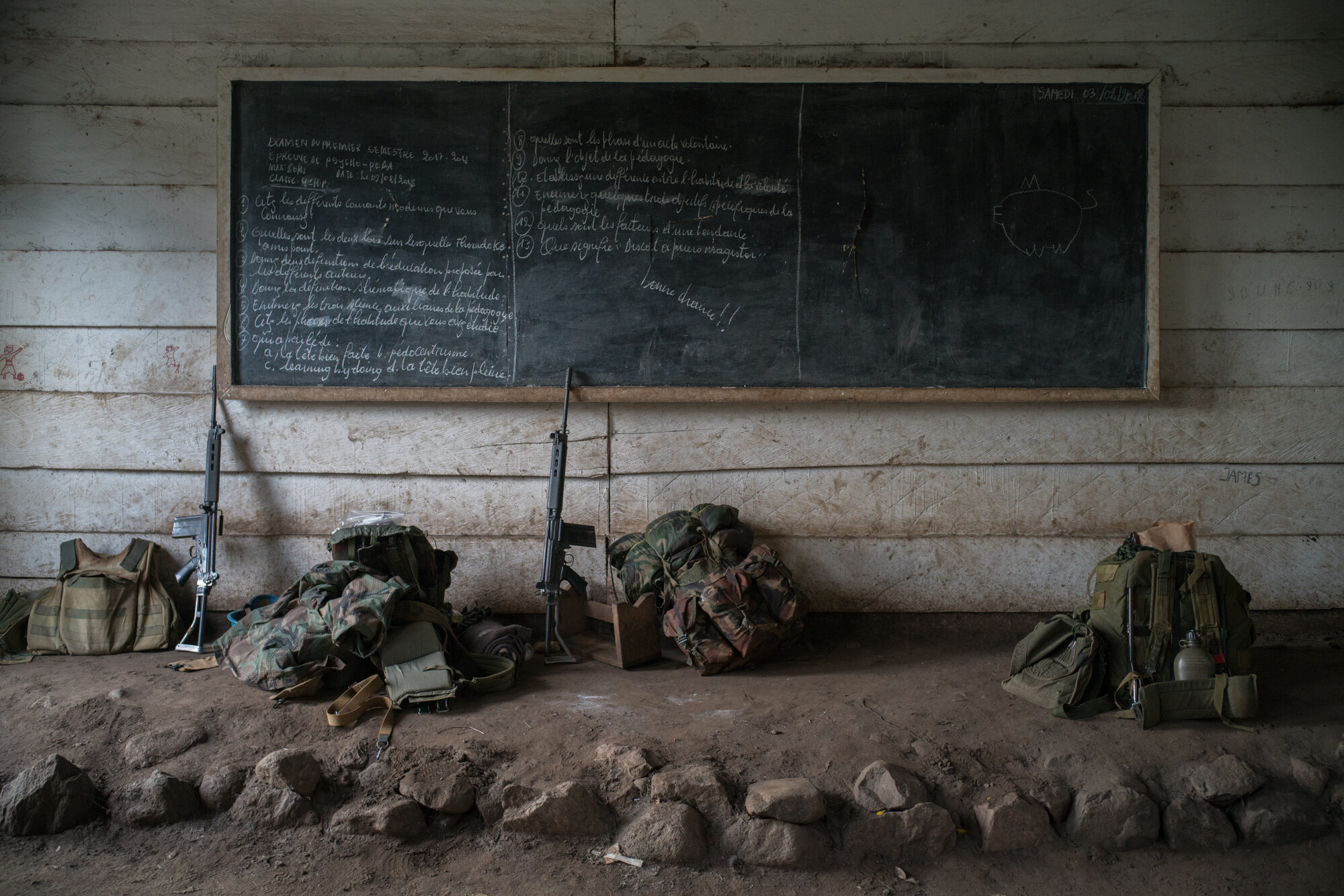
Uruguyan peacekeepers set up a makeshift base for the night in the abandonded school in Joo, one of the villages along the coast of Lake Albert, deserted and decimated after attacks on March 12 that left a reportedly 42 people massacred across the villages in this area. The location of the villages - wedged between Lake Albert and mountains - makes it particularly difficult to reach them. Uruguyan soldiers were the first to reach Joo, on March 16, after crossing the mountains on foot. The peacekeepers found cadavers and militias, who attacked them on two occasions over the three days and nights the soldiers spent there. On March 22, Uruguyan forces returned to Joo a second time. The militias were again spotted in the surrounding clifftops. March 22, 2018. Joo, Ituri province, Democratic Republic of the Congo.
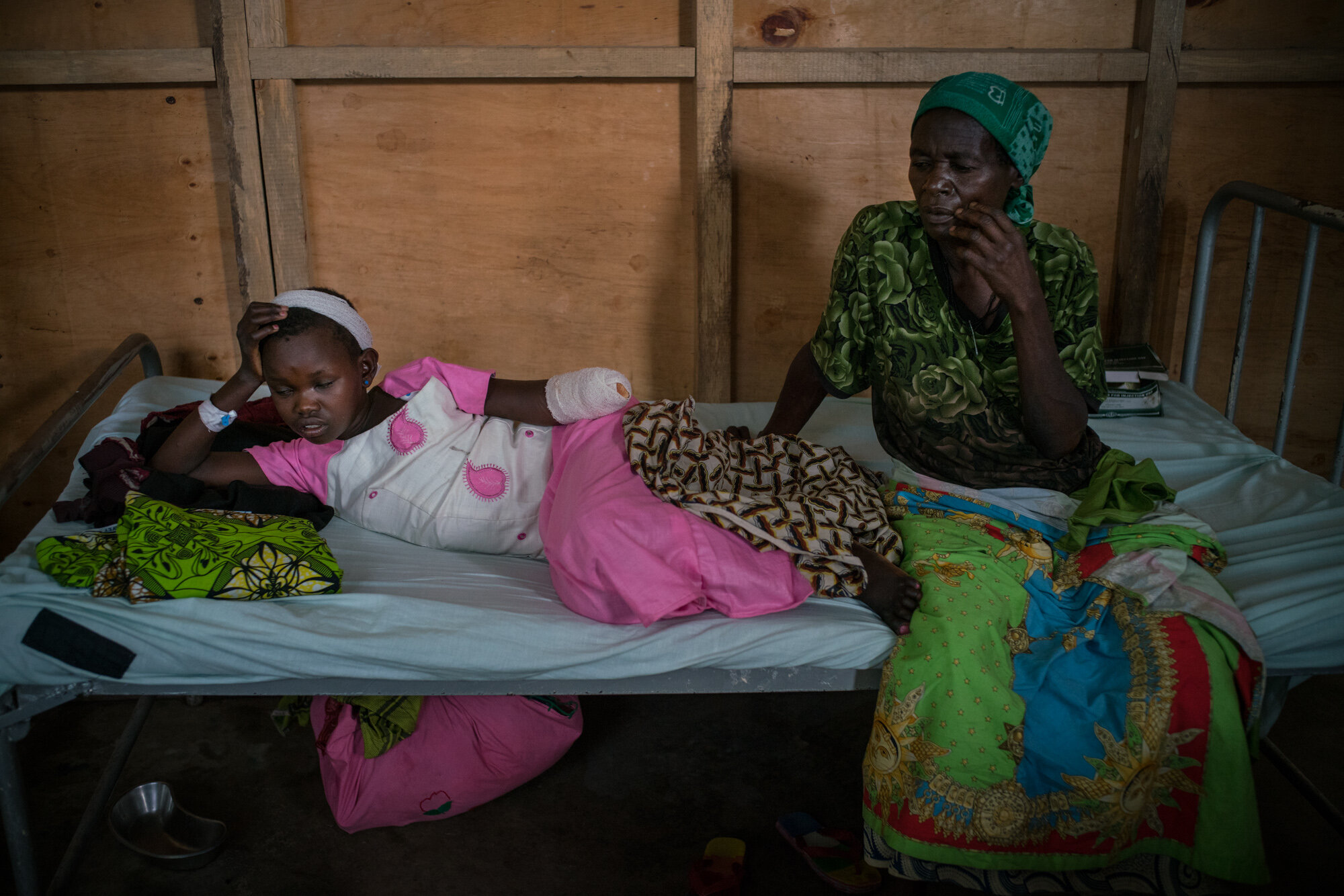
Grace Mave, 12, barely survived the attack on her village, Tche, 75 km north of Bunia, on February 11. Militias attacked in the morning at 10 AM. Grace watched as they raped her pregnant mother and used a machete to cut open her belly and remove the fetus. They killed her mother, and her 4-year old and 3-year old siblings. The militias also attacked Grace, her 2-year old sister, and her father with machetes. They chopped off Grace's left hand, and slashed her across the back of the head and the left side of her neck. Grace, with her baby sister on her back, and her father managed to escape into the bush. They hid there, among the cadavers, pretending to be dead for the rest of the day and night, afraid that the militias would return and kill them off as well. At 6 AM the following morning, they went back to the house to see what had happened. They came across other villagers who had survived the attack. They took Grace, her father and little sister to a health center in Drodro, 30 minutes south by moto. A week later, Doctors Without Borders / MSF transfered them from Drodro to the hospital in Bunia. March 14, 2018. Bunia, Ituri province, Democratic Republic of the Congo.
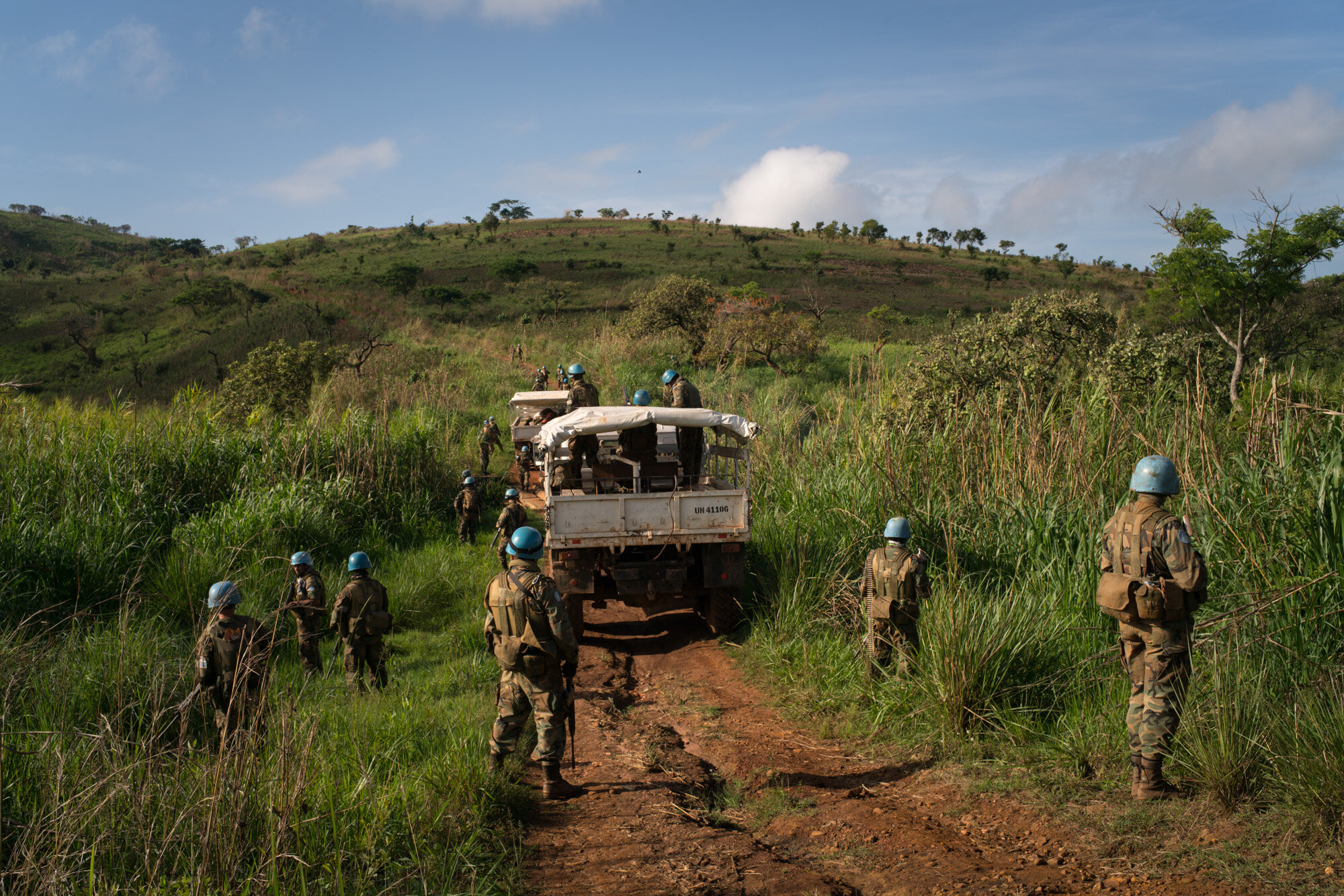
Uruguyan peacekeepers travel from Bunia to Kafe, on an operation to reach Joo, Ghbi and Dii, three remote villages were 42 were left dead after attacks on March 12. The villages are nestled between the shores of Lake Albert and a string of mountains, making them particularly difficult to reach. March 22, 2018. Djugu territory Ituri province, Democratic Republic of the Congo.






















IDPs attend a sermon in the largest camp in Bunia, host to approximately 10,0000 people. A second camp in Bunia hosts apporximately 4400 people. According to UN OCHA, the total number of those displaced to Bunia, living in camps and with host families is approximately, according 65,000, and the totoal bumber of IDPs from Ituri since January is is approximately 250,000. April 2, 2018. Bunia, Ituri province, Democratic Republic of the Congo.
Soldiers from the Armed Forces of the DRC, and UN peacekeeprs from the Uruguyan and Bangladesh batallions move through Ghat, a deserted lakeside village that lies in ruins after attacks from militias less than a week prior. They have come here to meet six Uruguyan soldiers who after succeeding to reach Joo, a decimated village further up the coast, were stuck there for three days and nights, surrounded by militias. March 18, 2018. Ghat, Djugu territory, Ituri province, Democratic Republic of the Congo.
The date on the blackboard of a ransacked classroom marks the last time class was held at the school in Lita, a town deserted and in ruins after it was attacked on March 4, 2018. Behind the school, the Uruguyan batallion of the UN peacekeeping mission to the DRC (MONUSCO) built a small field base from which they can have quicker access various parts of their operational zone in the troubled territoty of Djugu. March 16, 2018. Lita, Ituri province, Democratic Republic of the Congo.
Congolese refugees arrive to Sebagoro, Uganda, via boats used to cross Lake Albert, after fleeing the conflict in their home province of Ituri, Congo. Sebagoro, Hoima province, Uganda. March 9, 2018.
Uruguyan peacekeepers travel from Bunia to Kafe, on an operation to reach Joo, Ghbi and Dii, three remote villages were 42 were left dead after attacks on March 12. The villages are nestled between the shores of Lake Albert and a string of mountains, making them particularly difficult to reach. March 22, 2018. Djugu territory, Ituri province, Democratic Republic of the Congo.
Cadavers line the lakeshore in Joo, one of the villages that was attacked on March 12, leaving reportedly 42 people massacred. This is the body of Justin, 47, a fisherman. The location of the villages - wedged between Lake Albert and mountains - makes it particularly difficult to reach them. Uruguyan peacekeepers were the first to reach Joo after the massacre, on March 16, after crossing the mountains on foot. They found cadavers and militias, who attacked them on two occasions over the three days and nights the soldiers spent there. On March 22, Uruguyan forces returned to Joo. The militias were again spotted in the surrounding clifftops. March 22, 2018. Joo, Ituri province, Democratic Republic of the Congo.
Medicins Sans Frontiers / Doctors Without Borders cholera treatment center. Sebagoro, Hoima province, Uganda. March 9, 2018.
IDPs in the largest camp in Bunia, host to apporximately 10,0000 people. A second camp in Bunia hosts apporximately 4400 people. According to UN OCHA, the total number of those displaced to Bunia, living in camps and with host families is approximately, according 65,000, and the totoal bumber of IDPs from Ituri since January is is approximately 250,000. March 19, 2018. Bunia, Ituri province, Democratic Republic of the Congo.
Villagers transport a man out of Nyamamba village, where he had been hiding in the nearby bush when militias found him and shot him. Nyamamba lies in ruins after attacks a week prior. March 18, 2018. Nyamambda, Ituri province, Democratic Republic of the Congo.
Basima Bovias Nyau, 41, the chief of Dii surveys the scortched ruins of what was once the health clinic in his mountaintop village, attacked on March 13, just after the attacks on the previous day in the villages at the foot of the mountain, along the coast of Lake Albert, left a reportedly 42 people massacred. Even though they saw the neighboring lakeside villages attacked, people of Dii didn't leave because that same day, the village Chief of Dii spoke to the FARDC, and they told him they were going to arrive to protect them. But the FARDC never came. On March 13th, militias arrived - the burned the village and killed people. The location of the villages - wedged between Lake Albert and mountains - makes it particularly difficult to reach them. Uruguyan peacekeepers were the first to reach the lakeside village of Joo, on March 16, after crossing the mountains on foot. They found cadavers and militias, who attacked them on two occasions over the three days and nights the soldiers spent there. On March 22, Uruguyan forces returned to Joo, and on March 23, they reached Dii. The militias were again spotted in the surrounding clifftops. March 23, 2018. Dii, Ituri province, Democratic Republic of the Congo.
Congolese refugees wait at the reception center in Kyangwali, Uganda, where refugees spend several days before being transferred to a settlement (aka camp). Since December, approximately 50,000 refugees have arrived on boats used to cross Lake Albert, after fleeing the conflict in their home province of Ituri, Congo. Sebagoro, Hoima province, Uganda. March 8, 2018.
Uruguyan peacekeepers reach Ghbi, one of the extremely remote villages on the coast of Lake Albert that has been deserted since March 12, when attackers burned down homes and left a reported 42 massacred in this area. On March 16th, the peacekeepers were the first soldiers to reach the villages since the attacks. They found cadavers and clashed with militias on two occasions. March 23, 2018. Ghbi, Ituri province, Democratic Republic of the Congo.
The ransacked priest's chamber in the cathedral in Lita, a town deserted and in ruins after it was attacked on March 4, 2018. Next door, behind the school, the Uruguyan batallion of the UN peacekeeping mission to the DRC (MONUSCO) have built a small base from which they can have quicker access various parts of their operational zone in the troubled territoty of Djugu. March 21, 2018. Lita, Ituri province, Democratic Republic of the Congo.
IDPs receive the first distribution of aid since their arrival to Iga-Barriere town, 32 km north of Bunia, which marked the border of the red zone. To the north of it, countless villages were attacked by militias, who burned down the villages and killed inhabitants using machetes, arrows and fire arms. The most vulnerable IDPs received kits of non-food items - two blankets, 2 mosquito nets, a Jerry can, 1 plastic sheet, 2 mats, 5 soaps, 5 spoons - from Doctors Without Borders / MSF. March 15, 2018. Iga-Barriere, Ituri province, Democratic Republic of the Congo.
Soldiers of the Uruguyan forces to MONUSCO, the UN peacekeeping mission in the DRC, discover a partially decomposed corpse in Nyamamba, a deserted lakeside village that lies in ruins after attacks from militias a week prior. March 18, 2018. Nyamamba, Djugu territory, Ituri province, Democratic Republic of the Congo.
Francois Love, 30, and her children seek shelter in a school in Kasenyi, a town on the coast of Lake Albert. Kafe - mother of 5 - left 5 days ago. People here have fled their villages after militias arrived, burning houses and attacking people with machetes, arrows and firearms. Until a few days prior, IDPs gathered in Tchomia, X kilometers to the north. But when all villages to the north of Tchomia were attacked, leaving houses burned and many dead, IDPs deserted Tchomia as well, in fear of attacks reaching there. They now gather in Kasenyi. March 14, 2018. Kasenyi, Ituri province, Democratic Republic of the Congo.
Floribert Lobini, 42, receives treatment for his wounds - a machete slash across his back and a puncture in his arm by an arrow - in the hospital in Bunia. Floribert fled his lakeside village of Dzu when it was attacked on March 12, along with other villages on the coast. Reports said 42 were killed that day. He was next to the lake when he saw the attackers. Fortunately, his wife and three children had already left for Tchomia, the nearest town considered safe harbor. The attackers slashed Floribert with machetes, and shot at him with arrows. He managed to escape and hid in the bush for two days. When he came out to check on the village, he came across three corpses. He fled to Tchomia, but when he arrived there, he found it too was already deserted. In the hospital, he found one doctor who had stayed behind. Until recently, Tchomia had been a key point of refuge for those displaced by the conflict as well as the point of embarkation for those leaving by boat to Uganda. Once villages just to the north were burned down and massacred, people decided to flee from Tchomia as well, fearing attacks would reach there soon. The local doctor in Tchomia alerted Doctors Without Borders/ Medicins Sans Frontiers (MSF) about Floribert’s situation, so MSF made a special mission into the “red zone”, to rescue Floribert from Tchomia, in the “red zone”. At first, Floribert refused to leave Tchomia, saying he didn't want to leave his wife and children behind; he didn't know where they were. He was also afraid to go to Bunia as he had never been there before. MSF workers convinced him to get in the car: if he stayed in Tchomia, he would have died as the town was completely abandoned. March 14, 2018. Bunia, Ituri province, Democratic Republic of the Congo.
Soldiers from the Uruguyan forces of MONUSCO, the UN peacekeeping mission in the DRC, stops at Logo to try to make a radio call to 16 fellow soldiers who have gone missing for over 24 hours on a mission to reach Joo, one of the villages on the remote coast of Lake Albert in which 42 were reported dead after attacks on March 12. Beyond this point, roads are impassable by car and there is no FARDC or peacekeeper presence. They will go on foot to search for their lost colleagues. Poor communication networks, lack of roads, and mountainous terrain makes it especially difficult to secure territories like Djugu. March 16, 2018. Logo, Ituri province, Democratic Republic of the Congo.
Congolese refugees wait at the reception center in Kyangwali, Uganda, where they spend several days before being transferred to a settlement camp. Between December 2017 and March 2018, over 60,000 refugees arrived to Kyangwali on boats used to cross Lake Albert, after fleeing the conflict in their home province of Ituri, Congo. March 8, 2018. Kyangwali, Hoima province, Uganda.
Uruguyan peacekeepers set up a makeshift base for the night in the abandonded school in Joo, one of the villages along the coast of Lake Albert, deserted and decimated after attacks on March 12 that left a reportedly 42 people massacred across the villages in this area. The location of the villages - wedged between Lake Albert and mountains - makes it particularly difficult to reach them. Uruguyan soldiers were the first to reach Joo, on March 16, after crossing the mountains on foot. The peacekeepers found cadavers and militias, who attacked them on two occasions over the three days and nights the soldiers spent there. On March 22, Uruguyan forces returned to Joo a second time. The militias were again spotted in the surrounding clifftops. March 22, 2018. Joo, Ituri province, Democratic Republic of the Congo.
Grace Mave, 12, barely survived the attack on her village, Tche, 75 km north of Bunia, on February 11. Militias attacked in the morning at 10 AM. Grace watched as they raped her pregnant mother and used a machete to cut open her belly and remove the fetus. They killed her mother, and her 4-year old and 3-year old siblings. The militias also attacked Grace, her 2-year old sister, and her father with machetes. They chopped off Grace's left hand, and slashed her across the back of the head and the left side of her neck. Grace, with her baby sister on her back, and her father managed to escape into the bush. They hid there, among the cadavers, pretending to be dead for the rest of the day and night, afraid that the militias would return and kill them off as well. At 6 AM the following morning, they went back to the house to see what had happened. They came across other villagers who had survived the attack. They took Grace, her father and little sister to a health center in Drodro, 30 minutes south by moto. A week later, Doctors Without Borders / MSF transfered them from Drodro to the hospital in Bunia. March 14, 2018. Bunia, Ituri province, Democratic Republic of the Congo.
Uruguyan peacekeepers travel from Bunia to Kafe, on an operation to reach Joo, Ghbi and Dii, three remote villages were 42 were left dead after attacks on March 12. The villages are nestled between the shores of Lake Albert and a string of mountains, making them particularly difficult to reach. March 22, 2018. Djugu territory Ituri province, Democratic Republic of the Congo.